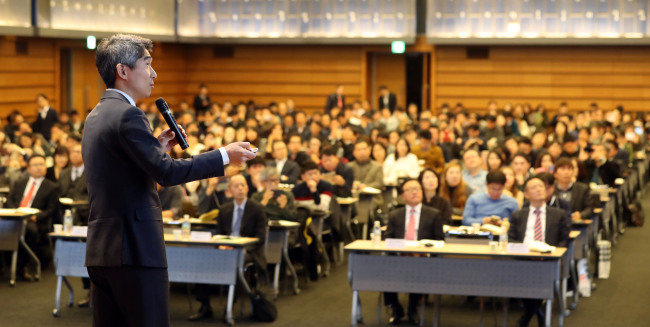Competitiveness in the retail sector will increasingly hinge on the ability of companies to integrate their online and offline strategies, according to experts speaking at the second “New Retail Trends and Future Growth Strategy” conference Tuesday.
The conference, hosted by the Korea Chamber of Commerce and Industry, invited specialists from Korea, China and Japan to share their insights on the developments of the retail industry in each country and their future direction.
 |
Accenture Managing Director Son Gun-il speaks at KCCI on Tuesday. (Yonhap) |
In all three countries, a common trend was the shift away from large brick-and-mortar companies in the face of rising e-commerce. However, the different retail landscapes of each country yielded some unique observations.
In Korea, the heavy competition among mobile commerce businesses was threatening not only offline retail spaces but also the businesses themselves with a race-to-the-bottom effect.
“Right now, Korean consumers do not really feel the inconvenience of online shopping that consumers overseas may feel, because the retailers take the cost burden associated with fast delivery onto themselves,” said Son Gun-il, managing director at Accenture Korea. “We have to think about whether that is sustainable.”
Son also said that 2016 could be the year when mobile commerce exceeds PC commerce, highlighting the need for retailers to optimize their online and offline strategies by defining the roles of each channel and combining them in the right way.
“An important factor to consider when strengthening a company’s channel portfolio is integration,” he said.
In China, according to professor Hansen Tian, the retail landscape is drastically shifting toward e-commerce under the leadership of Alibaba and JD.com, with a visible downturn in offline sales.
“However, in China the enjoyment of experience is still quite important,” said Tian, who expects the offline and online channels to eventually merge together. “In the future, we will be able to seamlessly see products offline and buy them online, in a completely integrated O2O (offline to online) era,” he said.
Meanwhile, in Japan, offline retail is moving away from large department stores toward smaller convenience store-type shops.
According to Kato Hirotaka of the Distribution Economics Institute of Japan, stagnant demand is intensifying competition for the most convenient retail format that provides the most satisfying experience and low prices, with the winners being Amazon Japan, the largest player in e-commerce, and convenience stores.
The conference, which also included presentations by eBay Korea Managing Director Na Young-ho and Taubman Asia Senior Marketing Manager Park Moon-jin, drew approximately 600 people from KCCI member companies.
By Won Ho-jung (
hjwon@heraldcorp.com)








![[Today’s K-pop] Blackpink’s Jennie, Lisa invited to Coachella as solo acts](http://res.heraldm.com/phpwas/restmb_idxmake.php?idx=644&simg=/content/image/2024/11/21/20241121050099_0.jpg)